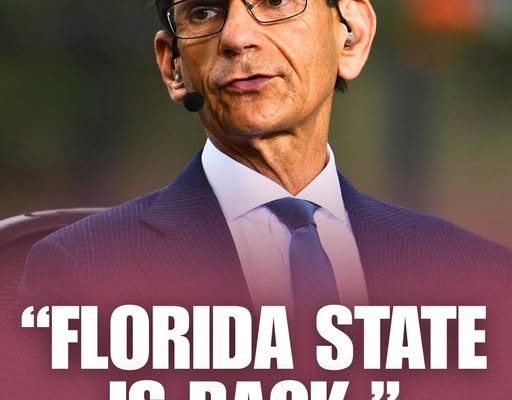Paul Finebaum, the longtime college football analyst and radio personality, made waves this week with his bold proclamation that Florida State University is “back” after the Seminoles’ strong 2-0 start to the 2025 season. For decades, Finebaum has been known for his candid assessments and sometimes controversial opinions, but when he speaks about college football programs gaining momentum, fans tend to listen. His latest commentary came after a recent game in which Florida State narrowly allowed a field goal, a moment that briefly frustrated him, but did not diminish his confidence in the Seminoles’ trajectory this season. His exact words captured both his critical eye and his optimism: “I’m in. I’m a little bit disappointed they gave up that field goal, I thought it was going to be perfect. But Florida State is back, mark it down right here. Sell all your stock in everything else. They have a long way to go, but I think Mike Norvell re-stocked his roster and they are looking legitimate. They do have a couple of big games ahead, though.”
Finebaum’s comments underscore a larger narrative about Florida State’s ongoing efforts to reclaim its stature in the college football landscape. Once a perennial powerhouse, the Seminoles have experienced periods of ups and downs in recent years, including coaching changes, roster turnovers, and fluctuating performance on the field. Yet, early indicators from the 2025 season suggest that the program is moving in a positive direction, and Finebaum’s endorsement adds weight to the growing conversation about FSU’s resurgence.
One of the central figures in this narrative is head coach Mike Norvell, whose leadership has been instrumental in rebuilding the team. Norvell’s tenure at Florida State has been marked by strategic recruiting, careful roster management, and a focus on cultivating talent that fits his system. According to Finebaum, the evidence of Norvell’s work is apparent in the team’s performance thus far. By “re-stocking” the roster, Norvell has not only brought in promising new talent but also maximized the potential of returning players who had previously underperformed or were overshadowed by other programs. This approach reflects a broader trend in college football, where success increasingly hinges on the ability to develop talent internally while navigating the complexities of the transfer portal and recruiting battles.
The Seminoles’ first two games of the season provide concrete examples of why Finebaum is optimistic. In these matchups, Florida State demonstrated a level of cohesion and competitiveness that has been absent in some previous campaigns. The offense, led by a combination of experienced playmakers and emerging stars, showed versatility and adaptability against diverse defensive schemes. Meanwhile, the defense exhibited resilience, managing to contain opposing offenses and force critical stops, even if they did allow a field goal that slightly disappointed Finebaum. These early performances have fueled the belief that FSU could be a legitimate contender this year, capable of challenging top-ranked programs and securing meaningful victories that restore confidence among fans and analysts alike.
Finebaum’s excitement also stems from the perception that Florida State’s schedule this season includes significant tests that will reveal just how far the team has come. While a 2-0 start is promising, it is not a guarantee of sustained success. The Seminoles still face several high-stakes matchups against formidable opponents, which will test the depth, strategy, and resilience of Norvell’s roster. Finebaum acknowledged this reality, noting that “they do have a couple of big games ahead, though,” signaling that while optimism is warranted, cautious attention is necessary. For fans and analysts, these upcoming contests will be pivotal in determining whether Florida State’s early success is a trend or merely an opening surge.
Another important factor contributing to Finebaum’s confidence is the psychological and cultural shift within the Florida State program. A strong start to the season can often galvanize a team, reinforcing confidence and cohesion among players, coaches, and the broader support network. Norvell’s approach emphasizes accountability, discipline, and competitive excellence, all of which have likely contributed to the Seminoles’ improved performance. The sense of momentum created by early victories can have a compounding effect, encouraging players to perform at higher levels and instilling a belief that they belong among college football’s elite programs. Finebaum’s assertion that “Florida State is back” reflects not just tangible on-field results but also an intangible sense of renewed purpose and identity within the team.
In addition to on-field performance, the broader landscape of college football provides context for why Finebaum’s proclamation carries significance. The 2025 season is characterized by heightened competition, with traditional powerhouses and emerging programs vying for prominence in increasingly complex conferences. For Florida State to re-establish itself as a national contender, it must navigate a landscape that includes not only athletic performance but also recruiting battles, media scrutiny, and strategic planning. Finebaum’s comment about selling stock in other programs is emblematic of the confidence he places in FSU’s ability to compete at a high level despite these challenges. It suggests that he views the Seminoles as a team capable of rising above the noise and making a significant impact on the national stage.
Recruiting remains a critical component of Norvell’s strategy and a key reason for Finebaum’s optimism. In recent years, Florida State has focused on attracting high-caliber athletes who can make an immediate impact, as well as developing younger talent for sustained success. This dual focus on immediate performance and long-term growth has allowed the program to balance short-term victories with a vision for future competitiveness. The ability to identify and nurture talent effectively can be a game-changer in college football, and Finebaum’s remarks indicate that he sees evidence of this process working successfully at FSU.
The Seminoles’ early-season performance has also been marked by notable individual contributions, which have reinforced the sense of momentum surrounding the team. Standout players on both offense and defense have stepped up in critical moments, executing plays with precision and demonstrating leadership on the field. These individual efforts, combined with strong coaching and strategic planning, create a formula that Finebaum believes positions Florida State for success in the remainder of the season. While he tempered his praise with acknowledgment of areas for improvement, his overall tone was one of enthusiasm and belief in the team’s potential.
Finebaum’s commentary also touches on the role of public perception in college football. Analysts, media personalities, and fans all contribute to the narrative that surrounds a team’s performance. By publicly declaring that “Florida State is back,” Finebaum influences how the broader football community views the Seminoles. This type of endorsement can have ripple effects, boosting recruiting efforts, increasing fan engagement, and placing psychological pressure on opposing teams. In a sport where confidence and perception often play critical roles, Finebaum’s bold statement is more than commentary—it is part of the ecosystem that can shape a team’s trajectory over the course of a season.
It is important to contextualize Finebaum’s enthusiasm within the realities of college football, where early success does not always translate into championships or long-term dominance. Florida State still faces hurdles, including maintaining player health, executing consistent game plans, and responding to in-game adversity. Finebaum himself acknowledged the challenges ahead, implying that while the Seminoles are on a promising path, the journey toward sustained success requires focus, discipline, and adaptability. The acknowledgment of these challenges demonstrates that Finebaum’s optimism is measured and rooted in a nuanced understanding of the sport.
Another layer to consider is the competitive environment of the Seminoles’ conference and national standing. Florida State’s schedule features opponents with varying strengths and styles, requiring a team capable of adapting week to week. Finebaum’s belief in the team’s legitimacy is grounded in the observation that Florida State has shown flexibility and resilience, traits that are essential for navigating a grueling season. Whether facing high-powered offenses or disciplined defensive units, the Seminoles’ early performances suggest a capacity to meet diverse challenges, further justifying Finebaum’s declaration.
Fan engagement also plays a significant role in the narrative of Florida State’s resurgence. Enthusiasm from supporters can influence both morale and performance, creating an energized atmosphere for home games and providing psychological advantages during challenging contests. Finebaum’s statement resonates with fans, providing validation for their optimism and fostering a sense of community around the team. As the season progresses, the alignment of fan support, player performance, and coaching strategy will be crucial in sustaining momentum and translating early success into meaningful outcomes.
Historically, Florida State has been associated with periods of dominance under legendary coaches and standout players. Finebaum’s comments suggest that the current iteration of the program is recapturing some of that historical prestige. By highlighting the effectiveness of Norvell’s roster management and coaching philosophy, he underscores the potential for Florida State to reclaim its place among the elite programs in college football. This perspective connects past achievements with present performance, framing the 2025 season as a potential turning point in the program’s trajectory.
Finebaum’s public endorsement also emphasizes accountability and high standards. By expressing disappointment over a single field goal allowed, he signals that expectations for Florida State are not only high but precise. This type of commentary reinforces the idea that success requires attention to detail, consistency, and execution at every level. Players and coaches can interpret such observations as both a challenge and an affirmation, motivating continued effort and improvement.
In conclusion, Paul Finebaum’s assertion that Florida State is back after a 2-0 start reflects a combination of tangible performance indicators, strategic roster management, and broader cultural shifts within the program. His commentary highlights the leadership of Mike Norvell, the emerging talent on the roster, and the potential for the Seminoles to re-establish themselves as a national contender. While he acknowledges the challenges ahead, including key upcoming games and the need for sustained performance, Finebaum’s optimism underscores the belief that Florida State has the ingredients necessary for a successful season. For fans, players, and analysts alike, this endorsement serves as a rallying point, reinforcing the narrative that the Seminoles are on the rise and positioning them as a team to watch closely in 2025. Whether the Seminoles can sustain this momentum remains to be seen, but Finebaum’s confidence suggests that early signs point toward a meaningful and potentially transformative season. The coming weeks will test this assertion, but for now, the message is clear: Florida State has made a strong start, and according to one of college football’s most influential voices, the program is back in the conversation.
This article is meant to engage fans and analysts alike, encouraging discussion and debate about Florida State’s trajectory. With the season still young, sharing opinions, predictions, and reactions to both the team’s performances and Finebaum’s commentary can foster a deeper connection to the sport. Fans are invited to weigh in on whether they agree with Finebaum’s assessment, which aspects of the team inspire confidence, and how they foresee the Seminoles navigating the remainder of the season. The conversation is just beginning, and the excitement surrounding Florida State provides fertile ground for ongoing dialogue and engagement.



